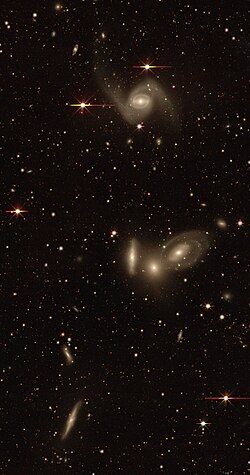Astronomy:NGC 1721
From HandWiki
Short description: Lenticular galaxy in the constellation Eridanus
| NGC 1721 | |
|---|---|
 | |
| Observation data (J2000 epoch) | |
| Constellation | Eridanus |
| Right ascension | 04h 59m 17.4s[1] |
| Declination | −11° 07′ 07″[1] |
| Redshift | 0.015010[1] |
| Helio radial velocity | 4 500 ± 9 km/s[1] |
| Galactocentric velocity | 4 388 ± 10 km/s[1] |
| Distance | 200 Mly (61.3 Mpc)[1] |
| Characteristics | |
| Type | (R')SAB00(s)[1] |
| Size | 36.92 by 17.58 kpc[1] |
| Other designations | |
| MCG-02-13-027, PGC 16484[1] | |
NGC 1721 is a lenticular galaxy (S0) located in the constellation Eridanus. It was discovered on the 10th of Nov 1885[2] by Edward Emerson Barnard. This galaxy is a member of the NGC 1723 Group—consisting of NCG 1723 (the brightest member, 11.7-mag) and a close triplet of NGC 1721, NGC 1725 and NGC 1728.[3]
NGC 1721 is a Dreyer Object (a now archaic astronomical term), meaning that it was included in the original New General Catalogue by JLE Dreyer.[4]
References
- ↑ 1.0 1.1 1.2 1.3 1.4 1.5 1.6 1.7 1.8 "NED results for object NGC 1721". NASA/IPAC Extragalactic Database (NED). http://ned.ipac.caltech.edu/cgi-bin/nph-objsearch?objname=NGC+1721&extend=no&hconst=73&omegam=0.27&omegav=0.73&corr_z=1&out_csys=Equatorial&out_equinox=J2000.0&obj_sort=RA+or+Longitude&of=pre_text&zv_breaker=30000.0&list_limit=5&img_stamp=YES.
- ↑ "cseligman.com". http://cseligman.com/text/atlas/ngc17.htm#1721.
- ↑ "NGC 1723 Group". http://www.deepskypedia.com/wiki/NGC_1723_Group.
- ↑ Burnham, S. W. (1894). "Observations of nebulae with the 36-inch refractor of the Lick Observatory – by S. W. Burnham (Publications of the Lick Observatory)". Publications of Lick Observatory 2: 168. Bibcode: 1894PLicO...2..168B.
External links
Coordinates: ![]() 04h 59m 17.4s, −11° 07′ 07″
04h 59m 17.4s, −11° 07′ 07″
 |

